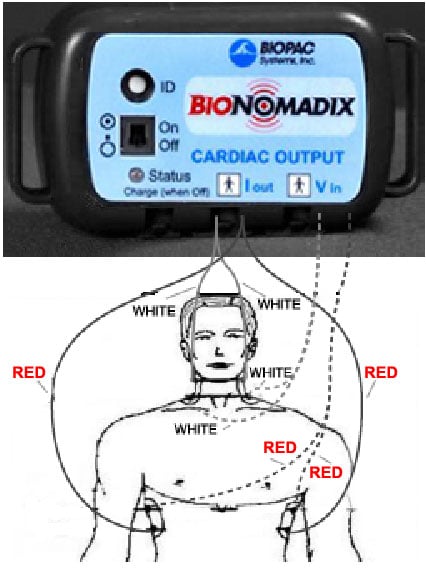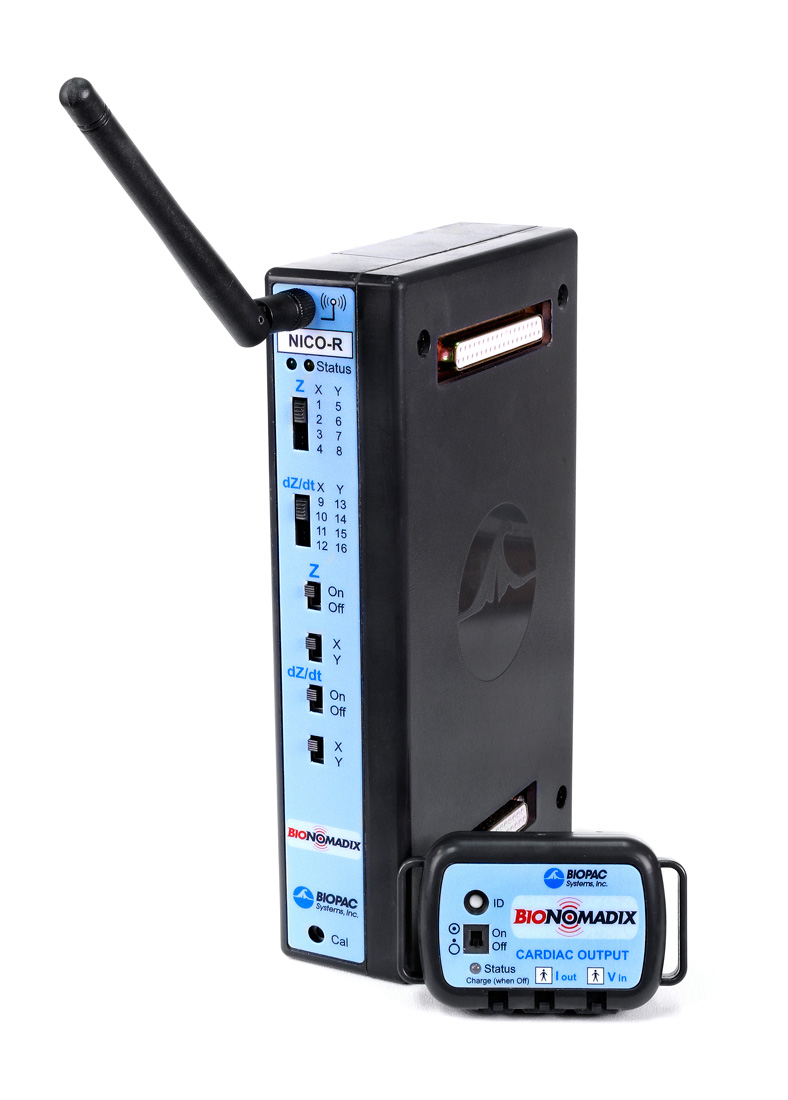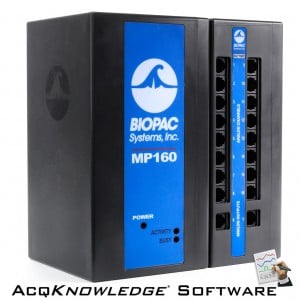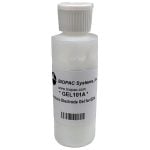*Transmitters shipped before 11/2016 are bandlimited from DC to 10 Hz.
The module pair is designed to emulate a “wired” connection from the computer to subject, with all the benefits of a fully-wireless recording system.
The module pair is typically used to measure cardiac-related impedance changes in the body via a tetrapolar electrode configuration. Generally stated, at least two “outside” electrodes are used to source a constant AC current (1 ma rms at 50 kHz) and at least two “inside” electrodes are used to measure the voltage across the impedance under investigation. Because the current is constant, the measured voltage is directly proportional to measured impedance
- NICO LEAD SETS – Use two per Transmitter: BN-EL50-LEAD4 for EL500 spot electrodes or BN-EL50-LEAD2 for 3rd-party electrodes/electrode tape.

Sample connection for NICO leads and spot electrodes:
A variety of tetrapolar electrode arrangements can be accommodated with the module pair. Multiple electrodes can be used to source/sink the applied constant current to reduce current density at any one electrode site. Equipotential (strip) electrodes can be used on the voltage sense electrodes to establish a clear measurement line for determining electrode distances for use in stroke volume estimating formulas (such as Kubicek, Sramek or Sramek-Bernstein).
Use AcqKnowledge‘s impedance cardiography analysis tools to perform dZ/dt classification, motion artifact removal, Pre-ejection period (PEP) estimation and a variety of related indexes and ratios. Click for ICG Analysis details and watch the tutorial videos.
Due to battery operation of the wireless transmitter and close proximity to the subject’s body, common-mode rejection ratio is extremely high, considerably in excess of any typical wired biophysical signal recording system. The high signal to noise ratio and high time-based sampling resolution permits the module pair to be used for precise cardiac impedance, stroke volume and cardiac output research studies. Impedance measurement can also be synchronized to specific stimuli for a variety of stimulus/response investigations, such as those associated with Challenge and Threat.
Attach the transmitter near, or on, the subject’s torso via stretchy Velcro strap (included) or try the stretch-mesh, pocketed BioNomadix Shirt. Interference with other recording modules or systems is greatly minimized because the module transmitter is completely battery operated and Operates totally independently of any other recording grounds or power sources. The recording transmitter is also extremely safe to use, because there is no physical connection to supply mains.
The BioNomadix Cardiac Output (NICO) transmitter with strap is worn by the subject to amplify and send the physiological data, and a matched receiver module provides high-quality cardiac output data (Z and dZ/dt). The BioNomadix NICO transmitter uses digital transmission and short leads placed close to the signal source to provide excellent signal quality. BioNomadix are configured for specific signal types, so you don’t have to adjust settings on the hardware or software for high quality cardiac output data.
The new BioNomadix series of wireless, wearable physiology monitoring devices for life science research noninvasively records high quality data while comfortably allowing subjects to move freely in natural indoor environments.
- Digital transmission to provide excellent signal quality for one or many subjects, for one or many signals.
- No hardware or software settings required for high quality, full bandwidth data.
- Use multiple BioNomadix to provide the optimum signal combination for biopotential or transducer signals.
- Use with a BIOPAC MP System to record up to 16 channels of BioNomadix data for multi-subject or multi-parameter protocols.
- Works with multiple MP160/150 systems or third-party data acquisition hardware via an isolated power supply module.
- AcqKnowledge software adds sophisticated automation and scoring routines for each signal type, plus customization options.
- BioNomadix accessory items include transducers, electrode leads, and a custom, pocketed sports shirt to comfortably hold multiple devices in place.
The BioNomadix line provides all the benefits of a wireless solution
with the signal quality & integrity of a wired system.
Add this cost-efficient option for uncompromised wireless physiology!
Product Options
Platform Options
MODULAR CONSTRUCTION
Amplifiers snap together for easy system configuration and re-configuration.
Intuitive, Elegant AcqKnowledge Software
Powerful automated analysis. Instantly & easily view, measure, analyze, transform, and report data.
Powerful MP160 Data Acquisition and Analysis System
Flexible, proven modular data acquisition and analysis system for life science research.









Stay Connected